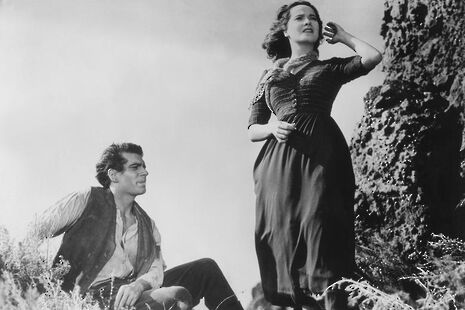Film: The Trouble with Adaptations
Jamie Rycroft discusses the different movie adaptations of Wuthering Heights

At the moment, movie adaptations are making money. Whether based on comic books, novels, or other forms of media (including board games, theme park rides, even pregnancy guides), Hollywood only wants to ‘franchise’ familiar material, to such an extent that few ‘original’ movies are being thrust into the limelight.
There is obviously a lot to bemoan here, but perhaps the prevalence of adaptations is not one of them. Many movies made in the 1930s, the ‘golden age’ of cinema, were adaptations of plays or novels. Stanley Kubrick, the archetype of auteur directors, almost never made a film not based on an existing fiction. For as long as there has been cinema, people have used it to tell older stories.
But there are issues inherent in adaptation, which goes to explain why many movies can be based on the same story and still be completely different. It’s perhaps easiest to show this through an example, so let’s kick off this column by discussing some adaptations of Wuthering Heights.
It’s fascinating how Wuthering Heights has achieved the status of a classic when few people actually know the full story. Ask someone who hasn’t read the novel and they’re likely to mention the passionate, doomed love affair between Cathy and Heathcliff, but that only takes up half the book. The rest of the plot is not so much a love story as a revenge story. Heathcliff avenges the bullying he suffered from Cathy’s brother, Hindley, as a child by raising Hindley’s son as a dullard, only to have his plans thwarted by the forces of true love.
Wuthering Heights is sublime; it’s one of my favourite books. But it’s a deceptively complex work. It has no central protagonist, only an ensemble of characters, all despicable in some way (though all the more compelling for this reason), within a plot that requires a family tree to understand, and using a framing device that only really works in writing. For a movie to adequately tell this tale, it either needs to dispense with this complexity, or rush through the story at the expense of pace and atmosphere.
The classic 1939 version, starring Merle Oberon as Cathy and Laurence Olivier as Heathcliff, goes for the former option, ignoring the second-generation narrative and instead focusing on Cathy and Heathcliff’s love affair. The swooning music that plays when Olivier screams out lines like “Cathy, my love!” paints the romance as completely sincere; darker elements of the story, meanwhile, do not appear. Olivier is a serviceable Heathcliff, though he looks too much like a Hollywood leading man to be a “dark-skinned gypsy”. The cinematography, meanwhile, is breathtaking: many of the shots of the moors are paintings, yet the lighting is so good that every landscape looks dark and suggestive. Oberon is probably the best actress to have ever played Cathy, as she manages to capture both the character’s tempestuous younger self and the repressed fair lady she becomes under her new lover, Edgar. These two personalities are so fully realised that she looks completely different when playing them, and can change her facial expressions and mannerisms in seconds, perfect for portraying a soul as inconstant as the Yorkshire weather. This classic film is certainly an entertaining watch on its own, but comparisons with the novel must be avoided. The title credits say “Screenplay from the novel by Emily Bronté” (inaccurate accent included), and it is perhaps best to treat it as a story inspired by the novel rather than an adaptation.
The 1992 version, meanwhile, opens with Brontë as the narrator, so we know off the bat that it is likely to be more faithful. Indeed, it’s one of the only versions to include the story’s second half, and for the most part this works well, though using the same actress who played Cathy to play her daughter is a poor choice. Ralph Fiennes displays a gloomier and more ambiguous Heathcliff. He seems less like a Romantic hero and more like a stalker, detached from the world, who counts the days Cathy is away from him, and lovingly strokes her corpse after her death. Since both of these moments are in the novel, I can’t really complain. The word ‘detached’ is a good word to summarise the feel of this adaptation: like in the novel, our experiences are always filtered through the narration of the nurse, Nelly, and we never quite become sympathetic for these characters. This creates an atmosphere which is not as immediately compelling as the 1939 version, but works well at showing a world of morally uncertain individuals. In its hurry, however, to paraphrase the entire novel in 100 minutes, many moments, especially Cathy and Heathcliff’s childhood, are hurriedly glossed over through montage or narration. Combined with the way that the cinematography, and indeed much of the acting, seems bland and washed-out, we have a version which is a good adaptation, but not a particularly good movie. As inaccurate as the Olivier version was, it had, unlike this, a sense of grandeur.
The 2011 version raised eyebrows by departing most radically from the original text. The taut, rhetorical dialogue of Brontë’s work is often replaced with lines like “fuck you all, cunts”. It is at the very least a breath of fresh air, and ironically, in stripping away the Romantic frills which have become associated with popular perceptions of the story, director Andrea Arnold comes closest to capturing the harsh, animalistic core of the novel. The moors become as much a character as the people, as the camera often spends much time meditating on the rustling of trees or the slaughtering of animals. More than in any other version, these places feel real, not a Hollywood sound stage or regal English house. But there are many flaws with this version. Since the actors are not allowed to reveal their feelings through language, they need to be talented at expressing them in other ways. But almost all of these actors are dull and wooden, and this has a detrimental effect on the story as a whole. We are not only detached from the action (like in the 1992 version), but detached from the movie. I began to become less interested in the fate of these characters and more interested in how much running time is left; indeed, for the longest of the three adaptations, it has the least plot, and definitely could have been half an hour shorter. Overall, this adaptation is a bold experiment, but never graduates beyond being an experiment.
These three adaptations show a few of the ways that adaptations can approach their original text: whether departing from it, following it reverently, or capturing the spirit of the work rather than its details. All three versions are interesting in their own right, and somewhere between the acting of the 1939 version, the plot of the 1992 version and the atmosphere of the 2011 version, there is the possibility that a future adaptation could perfectly capture the story. But for now, the magic of the moors can only be found in the pages of Brontë’s novel.
 News / SU stops offering student discounts8 January 2026
News / SU stops offering student discounts8 January 2026 Comment / Plastic pubs: the problem with Cambridge alehouses 5 January 2026
Comment / Plastic pubs: the problem with Cambridge alehouses 5 January 2026 Science / New year, new room, new you8 January 2026
Science / New year, new room, new you8 January 2026 Comment / What happened to men at Cambridge?31 December 2025
Comment / What happened to men at Cambridge?31 December 2025 News / Uni-linked firms rank among Cambridgeshire’s largest7 January 2026
News / Uni-linked firms rank among Cambridgeshire’s largest7 January 2026









